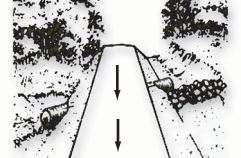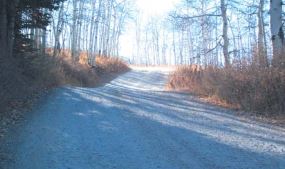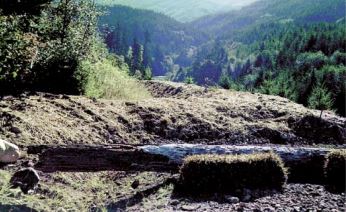010 - Managing Forests for Water Quality: Forest Roads
Forest Roads and Water Quality

This forest road is located well away from water. Its gravel surface promotes drainage and lessens erosion. The road is crowned, so water drains away to both sides.
Access to privately owned forest land is necessary for many reasons: forest management activities such as site preparation, planting, and harvesting; recreational activities such as hunting, fishing, hiking and camping; fire suppression; and access to home or cabin sites.
Water quality in forested areas can be impacted by many of these activities, including logging, fires, other construction, recreation, and grazing. However, poorly located, constructed or maintained forest roads are the largest source of non-point source pollution on forested lands. The greatest potential for degrading water quality comes from roads on steep slopes or erodible soils, and stream crossings. Research has shown that 90 percent of the sediment that ends up in our nation’s waters from forested lands is associated with improperly designed and maintained roads. Sediment in streams leads to a number of problems for fish populations including siltation of spawning beds and aquatic insect habitat, increased water temperature and reduced oxygen.
Water quality of streams, lakes and wetlands can be protected by starting with appropriately locating roads, followed by careful design and construction. Proper planning can help landowners reduce the number, width and length of roads, decrease maintenance requirements and limit visual and physical impacts to the land. Reducing the miles and width of road constructed also shortens construction time and saves money.
Road Planning
When determining the need for a road, think minimize. Every road constructed, no matter how carefully, will contribute to soil erosion and potential stream sedimentation. Therefore, the road system planned for a parcel of land should be the least amount necessary to accomplish the landowner’s goals. When planning, consider the entire site and possible future needs, since a well-placed and constructed road now may prevent the need for less well-planned spurs later.
Sometimes existing roads can be used. Upgrading an existing road may be less costly and damaging than constructing a new road. Any roads already present should be evaluated to determine if they are properly located for long-term needs, have adequate drainage, are suited for expected uses and are properly maintained. Many times, however, existing roads are in poorly chosen locations. Roads may closely parallel streams, have little or no vegetation between the road bank and stream or go straight up a draw or gully. Such roads probably should be moved or obliterated.
In the initial planning stages the type, location and design of any road should be based on:
- Future uses of the road: How heavily will the road be traveled? What types of vehicles will use the road (logging trucks and/or passenger vehicles)? During which seasons will the road be used? Is the planned use temporary or long-term?
- Site specifics: Consider soil types, slopes, geology, vegetation and runoff. Will storm runoff and/or flash flooding be a concern?
- Coordination with adjacent landowners: Will this road connect to a county, state, or Forest Service road? If so, contact them to see if a permit is necessary.
- Use of temporary roads whenever possible: A road used for one year or season can have a much smaller impact on local water quality than a permanent road.
Permits May Be a Requirement
Road construction on private lands in Utah may require one or more types of permits, depending on impacts on streams and wetlands. Check with the sources below to determine if you need any of these permits.
Streambank Alteration Permit or Wetlands Individual Permit: Construction of a stream crossing may require a Streambank Alteration Permit. If your road will cross a wetland, you may need a US Army Corps of Engineers Individual Permit. Contact the Utah Division of Water Rights at 801-538-7375, or visit their website for more information on both of these permits.
Stormwater Permit: Any construction project greater or equal to 1 acre requires a stormwater permit. Contact the Utah Department of Water Quality at 801-538-6146, or visit their website.
Recommended Road Planning Practices
- Locate roads on well-drained soils whenever possible. Avoid wetlands, seeps and other wet areas. Plan now for drainage features (see “Dealing with Drainage” section).
- Avoid unstable slopes (look for slumps, uneven topography, pistol-butted or J-shaped trees, dips, cracks or previous slides).
- Minimize the number of stream crossings. Identify optimum stream crossing locations first, and then locate roads to accommodate these crossings. (See Utah Forest Facts #9, Managing Forests for Water Quality: Stream Crossings.)
- Locate roads outside of streamside management zones. (See Utah Forest Facts #8, Managing Forests for Water Quality: Streamside Management Zones.)
- Locate roads to follow natural contours as much as possible. Minimizing cuts and fills will reduce the need for additional fill material or removal of excess material, while decreasing the disturbed area that needs to be revegetated.
- Keep road grades below 10 percent if possible. Roads may exceed 10 percent for short distances but will need drainage features and extra measures to prevent erosion.
Road Construction
Soil excavation, movement and compaction associated with road construction involves a high risk of soil erosion and stream sedimentation. Follow the guidelines below to minimize those risks. At all times, the goal is to keep soil and other construction materials out of streams and wet areas.
Road Surface Drainage
Shape the road surface to divert water off of the road. Three options for road shaping are shown below.
Crowned Road
- Drains from center to each side.
- Use in poorly drained soils, or with heavily traveled roads.
Out-sloped Road
- Drains to downhill side.
- Use on moderate slopes, stable soils
- Do not out-slope directly into streams.
In-sloped Road
- Slopes into uphill side.
- Drainage ditch along uphill side.
- Use in steep terrain or side slope.
Recommended Road Construction Practices
- Become familiar with the terrain by using topographic maps or aerial photographs and repeatedly walking the proposed road location. Use flagging to designate the road location.
- Avoid construction activities when ground is wet or frozen.
- Install erosion control measures such as hay bales or silt fences as needed. Remove when proper drainage features are in place.
- Construct roads in a manner that prevents debris, overburden and excess materials from entering streams. Deposit excess materials outside of streamside management zones.
- Compact all road fill material. Do not use snow, ice, frozen soil or woody debris as these will eventually melt or rot, causing voids that lead to road failure.
- Install road drainage at time of construction.
- Surface long term or permanent roads. Surface treatments include gravel, chipseal or pavement. On temporary roads, surfacing highly erodible areas (switch backs, steep grades, stream crossings) will reduce erosion.
- Maintain live trees and/or slash rows at the base of fill slopes to filter sediments.
- Avoid leaving berms that may channel water down the road.
- Reseed disturbed areas as soon as possible.
Cuts and Fills – Avoid if Possible
When building a road in steep terrain, it is usually necessary to cut into the hillside to create a flat road surface. The excess material excavated often becomes fill on the downhill side. Cuts and fills can create significant visual scars, are expensive to build and maintain, and should be avoided wherever practical. Both cut and fill slopes should be left no steeper than the angle of repose (the maximum angle that soil or rock will remain on a hillside without sloughing over time). Outslope the road, or construct a ditch along the uphill side and install a cross culvert for drainage.
When slope steepness is less than 50 percent, the material excavated in the cut can be used as fill for the outer portion of road; this is known as the side-cast method. Leave vegetation at the bottom of the fill slope to help stabilize the fill. If the slope steepness exceeds 50 percent, do not use the side-cast method. Any material excavated for the cut should be hauled away and deposited outside of wet areas and streamside management zones.
Dealing with Drainage
The most effective method for controlling erosion on forest roads is to keep water from accumulating on and running down the road surface. Water should be diverted from the road surface and dispersed into vegetation and ground litter with cross culverts, rolling dips, diversion ditches and water bars.
Cross Culvert

Cross culverts should be installed to drain water from either the in-slope road ditch or from natural water sources such as seeps or small springs. Size the cross culvert to adequately handle peak runoff and flood waters. Skew the culvert 15 to 30 degrees toward the inflow ditch to optimize inlet efficiency and reduce maintenance. Protect the upstream end from plugging by armoring with rock, or use a box or screen. If possible, install the culvert at the gradient of the original ground slope. If not, armor the outlet with rocks, logs or other material to dissipate the energy of the emerging water. Never allow the culvert to drain directly into a stream.
Rolling Dip

A rolling dip is a long hump, followed by a long dip, constructed in the road bed to divert water off the road. A proper dip is deep enough to provide adequate drainage and wide and long enough for trucks and equipment to pass safely. The rolling dip is placed at an angle to the direction of the road for ease of travel. The bottom of the dip is sloped to the outside to carry water away from the road. Rolling dips are best suited to road grades of 10 percent or less and each dip should be spread out over a minimum of 150 feet.
Diversion Ditch

A diversion or spreader ditch diverts water from the road into adjacent vegetation. Decreasing the velocity and spreading out the stream of water will allow sediment to settle out and water to be absorbed into the ground. Grade diversion ditches on a 2 to 3 percent slope to allow drainage. These ditches work particularly well when used in with a rolling dip, but can also work with an inside ditch or a cross culvert. A diversion ditch is the least expensive water diversion device.
Water Bar

Water bars are best suited for use on roads that receive little or no use for an extended period of time. To construct a water bar, excavate a trough 1 to 2 feet deep by 3 to 4 feet wide at an angle of 30 to 45 degrees across the road. Connect the uphill end of the water bar to the upper bank of the road. The downhill outlet should allow water to be directed into nearby vegetation. Because water bars are easily ruined when subjected to heavy traffic, minimize road use. Seed and fertilize the water bar to reduce erosion.
Road Use and Maintenance
Once road construction is complete, sensible use and maintenance will help prevent additional erosion. One of the most important aspects of road maintenance is keeping ditches and culverts operational and free of debris. Ditches on newly constructed roads may require frequent cleaning and checking after each major storm until vegetation has been established. Grading to maintain road shape and drainage also is important.
Recommended Use and Maintenance Practices

Geotextile is being used to strengthen this road through a wet area. Rock is laid on the wet surface, followed by geotextile and gravel on top.
- Avoid travel during wet conditions if practical.
- If a wet spot develops on a road, do not increase the problem by driving around it, thereby widening the wet spot. Instead, lay geotextile material over the area, followed by a 4 to 6 inch layer of gravel, to allow drainage.
- Clean culverts and ditches blocked by debris.
- Maintain water bars and rolling dips.
- Avoid undercutting the toe of cut slopes when grading roads or clearing ditches.
- Leave grass in the ditch unless it has filled with sediment and is no longer functioning.
- Grade roads only as often as needed to maintain a stable road surface and to maintain proper surface drainage. Unnecessary grading creates a source of sediment from the newly disturbed surface.
- When grading, avoid leaving berms that channel water down the road.
- Reduce dust by applying water, rock, or other appropriate road treatments.
- Close all roads that are unstable, erodible or unnecessary.
Winter Use and Maintenance
Winter provides an opportunity to conduct harvest operations in areas that might be sensitive during warmer, drier times. For example, wetlands and other wet areas can be accessed with less damage when covered by frozen snow pack. If properly maintained during winter months, road usage can extend harvest season without creating excessive impacts. Some recommendations for winter operation are:
- Remove snow from roads initially, to allow deep freezing which will increase stability of the road base.
- After roads have frozen solidly, keep 2 to 3 inches of packed snow on the road to insulate the frozen road base.
- Locate and mark existing culverts so they will be visible in deep snow and storm conditions.
- Keep all drainages open and culverts unplugged.
- Plow away snow berms or provide breaks in snow berms to allow road drainage, particularly as spring thaw occurs.
- During times of alternating freezing and thawing, suspend road use if deeply frozen road base begins to thaw.
- If ice bridges have been built to provide temporary stream crossings in winter, they must be removed prior to spring runoff.
Road Closure
When harvest and other forest management activities are concluded, the future need for the road system should be evaluated. If not needed, many roads can be closed, either temporarily or permanently, when management operations cease. Closing and rehabilitating roads can do much to prevent lake and stream sedimentation.
Recommended Road Closure Practices
- If closure is permanent, remove culverts and replace with water bars or rolling dips.
- Remove stream crossing structures. Stream courses and other drainages should be restored to their natural channels.
- Roads should be ripped or loosened so vegetation can grow. If natural revegetation is inadequate, plant with appropriate local species.
- If possible and appropriate, re-contour the roadbed to the original slope of the land.
- Barricade roads with logs, rocks, vandal-proof gates, or tank traps (very deep water bars) to prevent or control use by vehicles while revegetation occurs.
- If closure is temporary, do not remove drainage structures. Periodically inspect the road and drainage structures to ensure drainage is maintained.

Rocks and logs have been placed to block access to this closed road.

This road has been ripped and seeded, and access blocked with logs.
Forest Water Quality Guidelines
Utah’s Forest Water Quality Guidelines (FWQGs) are a collection of voluntary, field-applicable practices for use during forestry activities to protect soil and water resources. They are designed to minimize non-point source pollution such as sedimentation and erosion associated with forestry activities. For more information about the FWQGs and their application, contact your local Forestry, Fire and State Lands area office. A technical guide of the FWQGs is available.
Funding for this fact sheet was provided in part by the Environmental Protection Agency.
Published November 2004.

